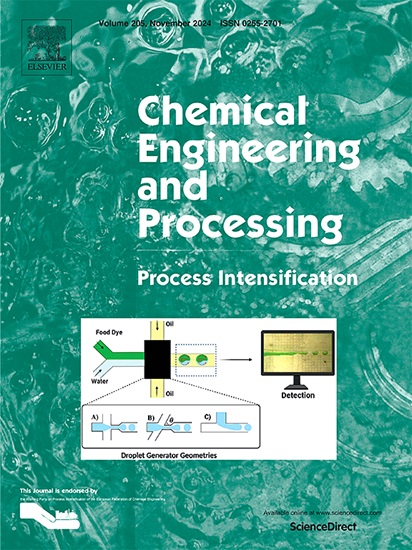两种不同管状气体喷射器的微泡塔反应器流动特性数值模拟
IF 3.8
3区 工程技术
Q3 ENERGY & FUELS
Chemical Engineering and Processing - Process Intensification
Pub Date : 2025-07-02
DOI:10.1016/j.cep.2025.110431
引用次数: 0
摘要
泡塔反应器(bcr)在工业中广泛应用于各种用途。然而,传统bcr的总反应速率受到气体分布不均匀和气液传质缓慢的限制。微泡技术被认为是提高bcr性能的一种有潜力的方法。本文采用计算流体力学(CFD)方法,研究了不同管状气体喷射器的微泡塔反应器(mbcr)内气液相的流动特性。根据文献中的实验结果对CFD模型进行了验证。结果表明,具有树形分布的mbcr的总气含率和界面面积分别增加了26.67% ~ 45.45%和19.55 ~ 23.68倍。在多环形分离器的mbcr中,上述参数分别提高了22.22% ~ 48.00%和18.00 ~ 23.27倍。与带有多个环形喷射器的mbcr相比,树形喷射器即使在低进口流量下也表现出显著的增强,从而实现了相当程度的节能。相信本研究将为大型管状气体喷射器的应用和优化提供可行的建议。本文章由计算机程序翻译,如有差异,请以英文原文为准。

Numerical simulation of flow characteristics in microbubble column reactors with two different tubular gas spargers
Bubble column reactors (BCRs) are intensively used in industries for different purposes. However, the overall reaction rate in traditional BCRs is constrained by the non-uniform gas distribution and slow gas-liquid mass transfer. Microbubble technology is seen as a potential method to enhance the performance of BCRs. In this work, computational fluid dynamics (CFD) simulations were performed to study the flow characteristics of the gas-liquid phase in microbubble column reactors (MBCRs) with different tubular gas spargers. The CFD model was validated against experimental results from the literature. The findings indicate that the overall gas holdup and the interfacial area in the MBCRs with tree-type sparger increase by 26.67 %∼45.45 % and 19.55∼23.68 times. In the MBCRs with multiple ring sparger, the above parameters increase by 22.22 %∼48.00 % and 18.00∼ 23.27 times. Compared to the MBCRs with multiple ring spargers, MBCRs with tree-type spargers demonstrate notable enhancement even at a low inlet flow rate, facilitating considerable energy conservation. It is believed that this work will provide viable suggestions for the application and optimization of large MBCRs with tubular gas spargers.
求助全文
通过发布文献求助,成功后即可免费获取论文全文。
去求助
来源期刊
CiteScore
7.80
自引率
9.30%
发文量
408
审稿时长
49 days
期刊介绍:
Chemical Engineering and Processing: Process Intensification is intended for practicing researchers in industry and academia, working in the field of Process Engineering and related to the subject of Process Intensification.Articles published in the Journal demonstrate how novel discoveries, developments and theories in the field of Process Engineering and in particular Process Intensification may be used for analysis and design of innovative equipment and processing methods with substantially improved sustainability, efficiency and environmental performance.

 求助内容:
求助内容: 应助结果提醒方式:
应助结果提醒方式:


